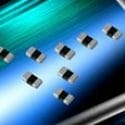source: AVX news
Ideal for a broad range of cross-market applications, these new AEC-Q200 qualified, ultralow capacitance varistors have high current & energy handling capabilities & provide bi-directional overvoltage protection & EMI/RFI attenuation in a single SMT package
FOUNTAIN INN, S.C. (July 19, 2017) — AVX Corporation, a leading manufacturer and supplier of advanced passive components and interconnect solutions, has released the new Antenna PowerGuard Series varistors, an ultralow capacitance extension of its reliable AntennaGuard range with new voltage, capacitance, and energy ratings. Antenna PowerGuard Series varistors exhibit highcurrent and energy handling capabilities, low insertion loss, low leakage current, and unsurpassed reliability compared to diode options. These advantages, combined with AEC-Q200 qualification, bidirectional overvoltage protection, EMI/RFI attenuation, fast response times (<1nS), and multi-strike capabilities make the small SMT packaged series ideal for use in RF and optic circuit, sensor, high-speed and data line, antenna, radar, Bluetooth®, Ethernet, and other capacitance-sensitive applications across the automotive, industrial, and commercial markets.
“Designed to handle higher transients than our proven-reliable AntennaGuard range, the new Antenna PowerGuard Series varistors are ideal for applications with capacitance-sensitive circuits that need to be protected against higher energy,” said Jiri Machanicek, product manager at AVX. “The series is also AEC-Q200 qualified, enabling its use in automotive applications.”
The new Antenna PowerGuard Series varistors are currently available in two case sizes (0402 and 0603), three working voltages (18, 24, and 30VDC), and three capacitance ratings (1.5, 2, and 3.3pF). The series features a 25kV ESD rating, energy handling capabilities spanning 0.02 – 0.04J, and peak current handling capabilities spanning 1 – 3A, and is rated for use in operating temperatures ranging from -55°C to +125°C with no derating. Antenna PowerGuard Series varistors also meet 48VDC jump start requirements, are AEC-Q200 qualified and RoHS compliant, and offer excellent solderability thanks to nickel-barrier, 100% tin (Ni/Sn) terminations. Parts are shipped on 7” or 13” reel, and lead-time for the series is currently 14 weeks.































